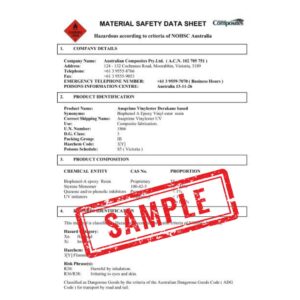Salon Boss: How to Decode Safety Data Sheets Step-by-Step!
Beauty Boss, we get it.
Running a salon involves juggling a multitude of vital aspects, and navigating the safe use of chemicals is definitely one of them.
But here’s the kicker: did you realise there are specific guidelines on this very topic, ones that are not just beneficial but legally mandated for your beauty business?
That’s where our latest guide swoops in: Salon Boss – How to Decode Safety Data Sheets Step-by-Step!
Get ready for a straightforward, no-nonsense approach to understanding Safety Data Sheets (SDS) for your salon.
These sheets are crucial for understanding the potential hazards of the products you use in your salon. By learning how to read and interpret them, you can take steps to minimise risks and ensure the safety of you and your clients.

Your salon’s safety is our priority, and by the end of this journey, you’ll be equipped with the knowledge and confidence to maintain the highest standards.
So, grab a cuppa, get comfy, and let’s dive right in!
- So what exactly is an SDS?
- Why does an SDS matter?
- The Relevance of SDS: Why Should Beauty Business Owners Care?
- The Legal Angle
- Insurance Implications
- Supplier Responsibility
- Cracking the Code: 7 Genius Ways to Decode Safety Data Sheets
- Step-by-Step Guide: Understanding the Key Sections of Safety Data Sheets
- In a Nutshell
- Explore More
So what exactly is an SDS?
Put simply: An SDS (formerly MSDS Material Safety Data Sheet) is a detailed document about a hazardous chemical.
It includes information like the chemical’s identity, hazards (health, physical, and environmental), its properties, workplace exposure limits, safe handling instructions, emergency procedures, first aid details, and transport info.
The SDS has 16 sections organised for easy reference.
Essentially, they are your guidebook to the safe use of every chemical that plays a part in your beauty business.
Why does an SDS matter?
Before we delve into dissecting an SDS, you need to understand why you need to know!
Safe Work Australia is an organisation in Australia dedicated to improving workplace safety and health.
They develop national policies and strategies to promote a safe and healthy working environment for all Australians.
Their goal is to reduce workplace injuries, illnesses, and fatalities by providing practical guidance, conducting research, and promoting best practices across various industries.
One of these standards mandates that businesses, including salons, must have Safety Data Sheets (SDS) for the chemicals they use.
These sheets provide vital information about the chemicals’ properties, hazards, and safe handling procedures.
Complying with SDS regulations not only meets legal obligations but also creates a safer environment, demonstrating your commitment to the well-being of everyone in your salon.
On the Safe Work Australia website, it states: “If you supply, use or store hazardous chemicals, you must keep copies of the SDS in your workplace. If you manufacture or import chemicals, you are responsible for making a correct SDS for each hazardous chemical.”

We know that these documents can seem daunting, especially for beginners, but don’t worry!
With a little knowledge and understanding, they can become powerful tools in maintaining a safe and compliant at-home beauty business.
The Relevance of SDS: Why Should Beauty Business Owners Care?
Apart from the regulations listed above, you may wonder why, as a beauty business owner, you should concern yourself with SDS sheets.
Safety Is Paramount
First and foremost, SDS sheets are the cornerstone of safety in your business operations.
They act as your guide to the safe handling, storage, and disposal of chemicals.
SDS highlight necessary protective measures, outline steps for accidental exposure, and detail procedures for handling chemical spills or leaks.
As a beauty business owner, your primary responsibility is the safety of yourself, your staff and your clients.
SDS sheets arm you with the knowledge to fulfil this responsibility.
Ignorance of chemical safety is a risk that no business can afford to take, making the understanding of SDS sheets an absolute necessity.
The Legal Angle
Importantly, in Australia, maintaining and understanding SDS is not just a matter of best practice – it’s a legal obligation.
The Model Work Health and Safety (WHS) Regulations mandate that all chemicals must be accompanied by SDS sheets, and these sheets must be readily accessible to all workers handling the chemicals.
Non-compliance with these regulations can result in severe penalties, including substantial fines.
“In the fiscal year 2019-20, Safe Work Australia reported that businesses were penalised over $22.3 million for breaching WHS laws“
To add to this, non-compliance can lead to reputational damage, a cost that can far outweigh the financial penalties.
Insurance Implications
Not following Safety Data Sheets (SDS) rules not only leads to legal issues but also affects your business insurance.
If you don’t comply, your insurance costs might rise, or you could be denied coverage.
Insurance companies prefer businesses that follow safety rules, offering them better rates and more coverage.
If there’s an accident and your business isn’t following SDS guidelines, it could complicate insurance claims.
To stay safe, work with salon insurance experts like BizCover who understand beauty businesses.

To stay safe, work with salon insurance experts like BizCover . They understand the beauty business.
Supplier Responsibility
In Australia, it’s a legal requirement for suppliers to provide SDS sheets for the chemicals they sell.
“The supplier of a hazardous chemical must provide, free of charge, a copy of the manufacturer or importer’s SDS with the chemical on first supply to the workplace or when asked to do so. If the supplier has not provided you with an SDS for the chemical you are using, you should ask for it before working with that chemical. If the supplier will not provide you with an SDS after being asked for it, then contact your local work health and safety (WHS) regulator.”
Safe Work Australia:
This means, as a beauty business owner, you are entitled to receive an SDS sheet for every chemical product you purchase.
Suppliers may have them readily available to download on their website or you can email them asking for specific sheets to be sent to you.
If a supplier fails to provide an SDS sheet, it’s a red flag.
It not only implies their non-compliance with Australian law, but it also raises questions about their commitment to customer safety.
Cracking the Code: 7 Genius Ways to Decode Safety Data Sheets

Now its time to delve into decoding the SDS. Here are seven genius ways to crack the code:
- Know the Format: SDS sheets follow a globally harmonised system, which means they all have the same 16-section format. Familiarise yourself with this format to know where to find the information you need.
- Understand the Language: SDS sheets use specific terminology. Take the time to learn what these terms mean to better understand the information.
- Don’t Skip the Details: Even the smallest details can be important. Make sure to read each section thoroughly.
- Use Reliable Resources: There are plenty of resources available to help you understand SDS sheets. Safe Work Australia is a great place to start. Here’s an awesome link to their factsheet Understanding SDS
- Ask for Help: If you’re unsure about something, ask. Your supplier or local regulatory body can be valuable sources of information.
- Keep them Accessible: SDS sheets should be kept where they can be easily accessed in case of an emergency. Check local council regulations on what is required.
- Stay Updated: SDS sheets should be reviewed and updated regularly to ensure they comply with any changes in regulations.
Step-by-Step Guide: Understanding the Key Sections of Safety Data Sheets
While all sections of an SDS sheet are important, there are a few key sections to pay special attention to:
- Hazard(s) identification: Section 2 – Here you’ll find information on the potential hazards of the chemical.
- First-aid measures: Section 4 – Describes the necessary first aid measures to be taken in case of an accident.
- Handling and storage: Section 7 – Contains details on how to handle and store the chemical safely to minimise the potential risks to people, property and the environment.
- Exposure controls/personal protection: Section 8 – This section outlines how to protect yourself when using the chemical.
- Other information: Section 16 – This includes a range of other useful information, such as when the SDS was last updated.
In a Nutshell
The importance of understanding SDS sheets for Australian beauty business owners cannot be overstated.
They’re not just paperwork; they’re like our safety net in the world of chemicals.
Picture them as your trusted guides.
They keep your salon safe, help you navigate the complexities of chemical use, and shield you from legal hassles and reputation risks.
Especially in our fast-changing beauty industry, where new products and treatments are always popping up, keeping up with SDS sheets is key.
So, let’s make it a habit.
Incorporate them into your routine, and you’re not just following the rules – you’re ensuring your beauty business is both secure and successful.
Stay safe, and keep shining in your beauty ventures!

We hope you enjoyed diving into this latest blog post?
Don’t keep the wisdom to yourself! Sharing is caring, after all. 🤗
Use this custom QR code to effortlessly share the knowledge with your friends, clients, and followers.
Let’s create a community of informed beauty lovers! Scan, share, and spread the love for all things beauty! 💖✨ #BeautyCommunity #SpreadTheKnowledge
Explore More
If you found this article insightful, you’ll love our in-depth guide on the ultimate nail battle between MMA and EMA managing chemicals in your beauty business. Dive right into it [here] for valuable tips and tricks!
👥 Join Our Community: Ready for more beauty biz talk? Join our lively Facebook group where beauty enthusiasts like you share experiences and knowledge. Click [here]to become a part of our vibrant community.
✉️ Stay Updated: Don’t miss a beat! Subscribe to our newsletter for the latest beauty trends, business insights, and exclusive offers. Be the first to know by subscribing below.
Thank you for being a part of our beauty community! We can’t wait to connect with you further.
Affiliate Disclaimer:
Just a heads-up: Some of the links in this post are affiliate links. What does that mean? It means that if you click through and make a purchase, I may earn a small commission, at no extra cost to you.
I only recommend products and services that I personally use and believe in. Your support helps me keep this passion project going, and I truly appreciate it! If you have any questions about the affiliate links used in this post, feel free to reach out
Xo Reet






